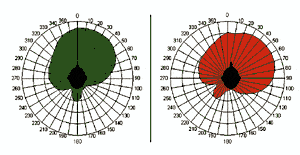In advertisements and on convention floors, HR readers may have come across a “new” company called ExSilent that offers an instant-fit modular CIC with some distinct design features. ExSilent’s products are unique both in their modular design and in the age and/or specific needs of patients for whom they’ve been created. HR recently interviewed ExSilent USA Sales Director Jeff Erdahl, a 17-year industry veteran, about the company, its unique products, and how they fit into the hearing aid market.
HR: Can you tell us about ExSilent, and give us a brief update?

ExSilent US Sales Director Jeff Urdahl
ExSilent was founded in Holland in the summer of 2005, and its Q completely-in-the-canal (CIC) hearing aid was initially offered in Europe. It has been available in over 25 countries, including the United States, for about 2 years, and our US headquarters is located in Eden Prairie, Minn. Currently, we’re making some very important additions to our product line, as well as some extensive revisions and changes to our existing devices.
ExSilent’s first product, called Q, was launched as the world’s smallest modular CIC, and it presented some new choices relative to size, shape, construction, and materials. In Holland, most of our R&D engineers came from the audio industry and academia, and it’s pretty clear that they think “outside the box” instead of what you typically see in our industry: “Well, a hearing aid has to conform to a certain design and look, so we’ll just apply a new twist or modification to a conventional design.” Instead, they really started with a fresh approach, and the results are pretty apparent.
Worldwide, the company is led by ExSilent Managing Director Wouter Haak, as well as European Sales and Marketing Director Hans Zwart. I think what you are now seeing is the benefit of combining both the Holland R&D team with the input from our US R&D team, which is led by Jan van Doorn, as well as long-time industry engineers Tim Peterson and Mark Bren, and audiologist Blane Anderson. When you get to the US market, audiologists and hearing instrument specialists are pretty savvy and particular when it comes to technology and fitting software. That’s where our group might be seen as “polishing” the original concept by saying, “Okay, right approach, but you also need to infuse the product with some well-established audiological concepts and features.”

Figure 1. Qleaf Pro CIC with AirTAP, a system for changing the four listening programs by tapping the device.
To that end, in February, we launched QFit v3.0 fitting software, which is now Noah-compatible. Additionally, our Qleaf Pro CIC (Figure 1) now contains a new chip platform that features state-of-the-art feedback and noise reduction capabilities. In terms of feedback, you can place this device in an ear and it will resist feedback even at 40 dB gain in loud environments. It also has AirTAP functionality: you just tap on the device to switch between the four different listening programs. We’re also coming out with a new form-factor—a microphone and receiver in the canal or MaRIC hearing aid—this spring.
So, ExSilent is starting 2011 with a lot to talk about in terms of upgrades, products, and software that I think most audiologists and dispensers will embrace and be very interested in.
HR: ExSilent started out by offering instant-fit CICs instead of BTE/RICs. Is there a reason for this?
We know that the mini-BTE and RIC-type products now account for about two-thirds of the market, and we think they’re a great product for consumers. However, we also feel that the market has moved a little too far in that direction. In my opinion, we’ve left out some patients who are looking for a product that’s different than BTEs, yet still offers instant fittings.
With ExSilent, if the patient is having trouble accepting a BTE or RIC—due to cosmetics or whatever reason—the clinician has an option of saying, “Hold on. I have a hearing aid that offers similar features; we can have you wearing it today, and the key difference is this aid actually goes in your ear.”
So ExSilent offers instant same-day CIC fittings with excellent sound quality and advanced features. I think other companies are also starting to understand that we can’t have a one-solution-for-everyone product that leaves out certain options and patient groups. It’s not that we don’t like RICs—in fact, we’re going to be introducing one this spring—it’s just that we feel we can provide some very interesting cosmetic and feature options that RICs cannot.
HR: Audiologically speaking, what differences are there in ExSilent products?
ExSilent technology emphasizes the use of what we call “natural hearing” due to the ear’s unique characteristics relative to the pinna and ear canal—having the microphone placement in the aperture with the receiver close to the eardrum. I know this isn’t an entirely novel concept since deep-fitting CICs are also capable of achieving the benefits associated with this approach; however, ExSilent does this while allowing for an instant-fit, so the customer can immediately try it out and wear the aid that day.
Our original products, Q and Qleaf, are instant-fit CIC devices that are shaped differently to accommodate the ear canal, and each is designed to provide greater wearing comfort for particular ear canal shapes. We know that the first bend of the ear canal is an important obstacle to these types of fittings. Qleaf is more of a rounded rectangular instrument than Q, and our field studies have shown that the two aids will fit about 70% to 75% of ears, but in actual clinical use this is probably more like 60% due to patient comfort issues. If you have a more pronounced first bend in your ear canal, Qleaf is probably the better choice; if your first bend is straighter, then it’s likely that Q is the better choice.

ExSilent Managing Director Wouter Haak
HR: Can you tell us about your upcoming MaRIC product?
This spring we’re introducing a new product, called YTango, that will incorporate a hybrid design we’re calling microphone and receiver in the canal—or MaRIC—technology. In a MaRIC device, the body of the hearing aid has a wire extending down to the dome tip just like a RIC. However, instead of just the receiver body being in the ear, the microphone is also located in the ear canal. When you slide the dome into your ear, just on the other side is a small microphone housed within the receiver unit. So now you have the microphone down in the aperture as opposed to sitting on top of the pinna. Again, this utilizes the natural advantages of the pinna and the ear’s anatomy while giving you the benefits of an RIC-type fitting.
From a fitting range perspective, YTango will be applicable for the same percentages of people as RICs—probably around 90% of the patients seen in an average dispensing office.
What YTango does is provide patients and dispensers with more choice. In the past, if the patient wanted an instant-fit CIC and the Q or Qleaf wouldn’t fit them, then the only real option they had was something akin to the Lyric. But with the advent of MaRIC, ExSilent now has a range of instant-fit products that should accommodate nearly anyone.
HR: One of ExSilent’s mottos is that “a hearing aid should not look like a hearing aid.” Not to sound overly defensive, but what do you mean by that?
ExSilent hearing aids don’t look like your grandfather’s hearing aids. One of the things we do with our product line is promote a newer and different look that will capture new users who have seen all the other hearing aid styles—ITEs, BTEs, mini-BTEs, and RICs—in advertising and in dispensing offices but still can’t quite seem to accept these designs, whether due to cosmetics or possibly to the associations with aging that those styles evoke for them.

ExSilent Q instant-fit CIC.
If you place the Q line of products on a table beside the more conventional styles, the patient will pick up the ExSilent hearing aid first, because our products really do look quite distinctive. These devices don’t look like a hearing aid. What we’re finding is that Q and Qleaf are attracting a slightly younger user group—mostly Baby Boomers and first-time wearers. Many of these people know they have a hearing problem, but they are not really looking for a hearing aid as much as they are looking for a “communication device”—or at least something that will “get them through the day” with the hearing they have.
HR: Despite millions of dollars in R&D and a lot of effort, the hearing industry hasn’t been very successful in breaking into the younger-user market. Why not?
There are many reasons. One has to do with the severity of the loss. The majority of hearing aid users that our industry serves are older people who have moderate-to-severe losses and have had some type of epiphany or an “aha” moment—missing out on a grandchild’s play or an embarrassing moment during a conversation—that demonstrated they really need a hearing aid.
In contrast, younger users with more moderate losses are experiencing their hearing problems as an inconvenience or irritation that might border on an embarrassing situation, etc, but have not necessarily come into the office out of dire necessity. Quite often, they’re seeking discreet products for specific situations—for work, meetings, classes, and regular get-togethers with friends or a book club, etc. I understand the professional concerns regarding “occasional hearing aid” use, but the fact remains that younger users with moderate losses can benefit greatly from hearing aids, even if they don’t necessarily wear them 16 hours a day. And Q and Qleaf are excellent products for this demographic, along with the industry’s more traditional user group.
It’s not like other manufacturers aren’t trying to do this, as well, with smaller CIC designs and RICs. However, our goal is that—as more and more Boomers walk into dispensing offices—ExSilent will be there to offer something that will specifically capture that demographic. We’re really focusing on designs and features for younger users, and I think you can readily see this in our product line.
For more information on ExSilent, visit the company’s website at www.exsilent.com.
Citation for this article:
Strom KE. ExSilent: Not your grandfather’s hearing aid. Hearing Review. 2011;18(3):72-73.





